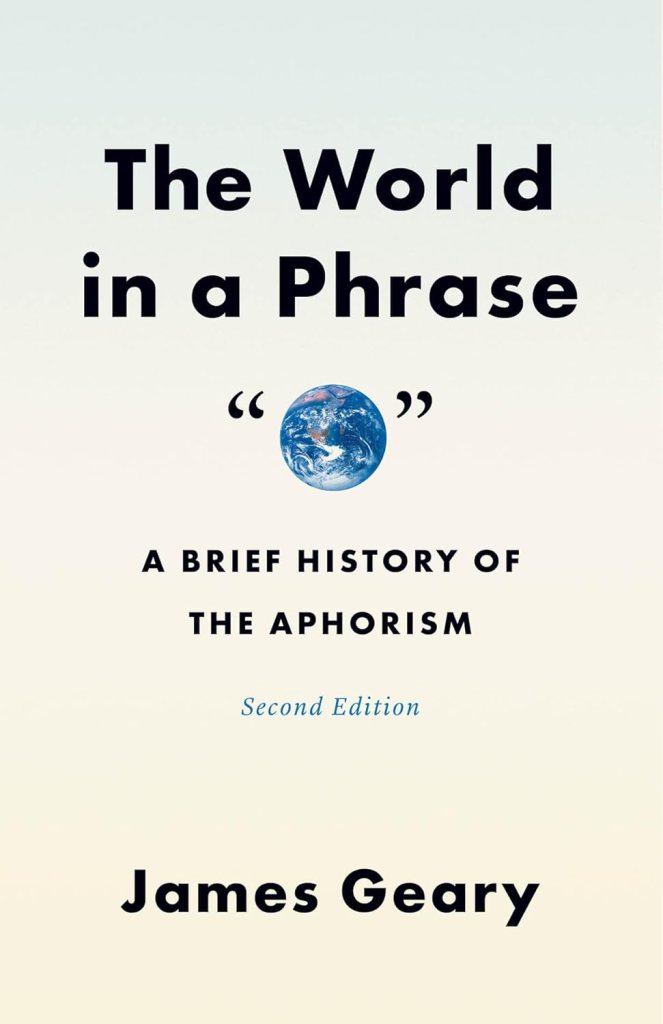Brief bursts of wisdom
Brief bursts of wisdom
Aphorism lover and historian James Geary reflects on how ancient literary art form fits into age of social media

Since James Geary, adjunct lecturer in public policy at Harvard Kennedy School, encountered his first aphorism at age 8, his love for them has only grown. So much so that in 2005, he published a bestselling book, “The World in a Phrase: A Brief History of the Aphorism.” The book’s second edition comes out this month.

In an interview, which has been edited for clarity and length, Geary spoke to the Gazette about the appeal of those short, philosophical phrases, how they differ from slogans or tweets, and why memes can be the new aphorisms.
What’s the appeal of aphorisms?
Aphorisms are the oldest written art form on the planet, but they’re also the most contemporary. With the rise of social media and short-form communication, in many ways the aphorism has found its perfect technological platform. So much of social media today is just toxic — hot takes, rage posts, and all that kind of stuff — but aphorisms from their beginning, 5,000 years ago in China and Egypt, were mostly philosophical thoughts. They’re often witty and are a very sophisticated form of literature that, unlike so much social media today, is not intended to confirm the opinions you already have, but to challenge and provoke you to think further and deeper.
How do aphorisms differ from proverbs, slogans, or tweets?
A key component of an aphorism is that it has to be philosophical; it has to make you think. And I don’t mean that it has to be esoteric or impenetrable, but about the ultimate questions in life. Aphorisms help us to examine our own beliefs, practices, and our own biases. They’re kind of a philosophy for daily life. Unlike political or commercial slogans or tweets, aphorisms provide answers to that old philosophical question of how to live a good life.
Aphorisms have to be super accessible; you can understand them in a second. And they often feature a twist that upends expectations. Mae West, a famous American actress from the 1940s, said, “It’s not the men in my life that count; it’s the life in my men.” Or JFK’s “Ask not what your country can do for you, but what you can do for your country.” Or French writer Nicolas Chamfort’s “Society is composed of two great classes: those who have more appetite than dinners, and those who have more dinners than appetite.” Their mode of delivery is brief, but the impact of a really good aphorism is long-lasting; they are in your head for a lifetime. I first encountered the aphorism “The only difference between a rut and a grave is the depth” when I was 8 years old, and it has never left my mind.
“Aphorisms have to be super accessible; you can understand them in a second. And they often feature a twist that upends expectations.”
You say in your book that memes are the new form of aphorism. How so?
Since memes appeared on the scene, I realized that aphorisms don’t have to involve language.
Aphorisms can work with visual or textual signs, or it can be a combination. Clet Abraham, for example, uses no words in his visual aphorisms; he takes street signs and twists them to bring out a philosophical meaning. Shilpa Gupta uses text, but she puts the text into the environment so it feels like you’re walking past an aphorism. Xu Bing, the Chinese artist, uses language but kind of distorts it, playing with the ways in which we perceive images and the way we understand language.
Memes are the next step in the evolution of the aphorism. But I wouldn’t say every meme is an aphorism, just like every tweet is not an aphorism. Even if it’s a meme or a visual textual combination, it should still have a twist, it should still be philosophical. The vast majority of memes or tweets are not aphorisms, but the aphorism is adapting to a newly accessible form of communication, which is visual, not only textual.
What’s the common thread among aphorists across eras? What are they preoccupied with?
Politics is a very common thread in many aphorisms from ancient times until today. An ancient Egyptian ruler passed his wisdom to his child who was going to succeed him by saying, “To rule is to know how to be ruled.” And then you have Stanisław Jerzy Lec, a Polish dissident who lived under Soviet rule, who wrote, “Politics: A Trojan horse race.” Daily life is a big theme along with love, friendship, relationships, and money. Mark Twain said, “The lack of money is the root of all evil.”
Austrian writer Marie von Ebner-Eschenbach said, “An intelligent woman has millions of born enemies … all the stupid men.” Polish writer Urszula Zybura said, “If the future had known what lay ahead, it would have never come,” which sums up the political history of Central Europe under Soviet rule. American thinkers such as Twain, Benjamin Franklin, Ralph Waldo Emerson, and Henry David Thoreau are concerned with individualism. Thoreau said, “Let him step to the music which he hears, however measured or far away.”
Do you have any aphorisms of your own?
Yes, I do. Usually, usually they come out of the blue, or when I’m writing something else, and an aphorism pops up in my mind. Here are a couple: “Even your disguise reveals you.” “If your expectations are low, you are certain to meet them.” These came out of my classes at the Kennedy School because good advice for writing is good advice for living.
Latest Harvard
- Time for mandatory retirement ages for lawmakers, judges, presidents?Americans seem to mostly say yes; legal, medical scholars point to complexities of setting limits
- In dogs, as in humans, a harsh past might bare its teethEarly adversity leads to higher aggression and fearfulness in adult canines, study says
- Flew home as Will Flintoft, returned as Rhodes ScholarApplied math concentrator to study computer science, theology with eye toward AI
- What will AI mean for humanity?Scholars from range of disciplines see red flags, possibilities ahead
- Tai Tsun Wu, 90Memorial Minute — Faculty of Arts and Sciences
- Richard Goody, 102Memorial Minute — Faculty of Arts and Sciences






